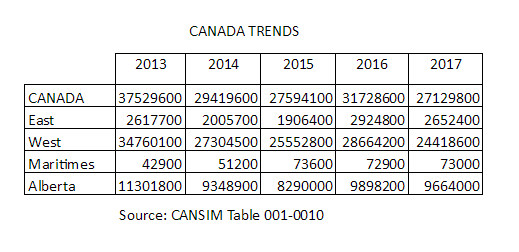GLOBAL AND NATIONAL SUMMARYGLOBALOverall, the growing season for crops has been a mixed bag depending on where one is on the planet. Worldwide, it was expected that extreme weather would impact production and this trend has played out. In this summary, we will be focusing on wheat production, the staple food of the world. According to the US Department of Agriculture (USDA), global food production this year settled at 753 million metric tons, 18 million metric tons more than 2016 (USDA, 2017,p.18-19). In 2018, it is expected that production will fall by a couple of million tons. U.S. wheat production increased 11% over last year and is expected to drop 25% for next year (USDA, 2017, p.11). European wheat production declined 10% (Bryant-Erdmann, 2017, Quality Reports, para. 6). Russian wheat production is a boon to the 2017 numbers, an increase of 18% over last year (Bryant-Erdmann, 2017, Quality Reports, para. 10). In the Southern Hemisphere, drought and excessive rain has resulted in the downward revision of crop production during the present growing season. Australia is expected to increase production but concerns about extreme weather affecting nutritional quality are growing (Bryant-Erdmann, 2017, Southern Hemisphere Wheat Development, para. 5). Argentina is suffering the same weather problems but increased land utilization of 10.6 million acres will result in a forecast of 19% increase from last year (Bryant-Erdmann, 2017, Southern Hemisphere Wheat Development, para. 2). NATIONALThis growing season was marked by extreme weather events, drought in the west and wet in the east. Current production totals for Canada are down from initial 5 year old total and 5 year average (Statistics Canada, 2017, CANSIM, Table 001-0010 ). With the exception of 2016, the trend for production is a gradual downward one. Why 2016 was different may have to do with the El Nino Southern Oscillation and the influence it has on the geographic regions on this continent (Trendberth, 2016, para. 3). Excessive rain or heat will have a negative impact on future production. Drought affected regions received around 40% of normal rainfall while wet regions received 150-200% of normal rainfall (Chadrick, 2017, para.5). Additionally, soil fertility is negatively impacted by the lack of soil moisture and leaching of nutrients in areas with too much moisture (Chadrick, 2017, para.6). This might account for the predicted decline projected for 2018 by the USDA and is also reflective of the decline trend by Statistics Canada. TAKEAWAY This downward trend for food production is certainly going to result in increasing food prices worldwide. As reported in the previous blog post concerning Canadian trends, food prices have risen in excess of 4% from last year and taken with the continuing decline in future production, this will make buying healthy more difficult. If you have resources, it is best to make preparations. SourcesBryant-Erdmann, S. (November 3, 2017). Wheat Markets Focus on Quality and Southern Hemisphere Crop Conditions. Agfax. Retrieved from http://agfax.com/2016/11/03/wheat-markets-focus-on- quality-and-southern-hemisphere-crop-conditions/ Chadrick, C. (November 16, 2017). Looking back on 2017”s biggest growing challenges. Grainews. Retrieved from https://www.grainews.ca/2017/11/16/looking-back-on-2017s-biggest-growing- challenges/ Statistics Canada (2017). Estimated areas, yield, production and average farm price of principal field crops, in metric units. Retrieved from http://www5.statcan.gc.ca/cansim/a03?lang=eng&pattern=001- 0010&p2=31 Trendberth, S. (January 4, 2016) What North America can expect from El Niño. The Conversation. Retrieved from http://theconversation.com/what-north-america-can-expect-from-el-nino-51959 U.S. Department of Agriculture (2017). World Agricultural Supply and Demand Estimates. Retrieved from https://www.usda.gov/oce/commodity/wasde/latest.pdf
0 Comments
|
AuthorWrite something about yourself. No need to be fancy, just an overview. Archives
March 2022
Categories |


 RSS Feed
RSS Feed